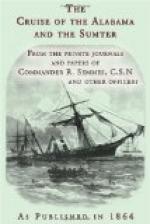Another moment and the scene was changed. The Yankee ensign had hardly reached her peak, when down came the beguiling signal from the Alabama’s flagstaff, and the white folds of the Confederate ensign unfurled themselves in its stead. A flash, a spurt of white smoke, curling for a moment from the cruiser’s lee-bow, and vanishing in snowy wreaths upon the wind, and the loud report of a gun from the Alabama, summoned the luckless Yankee to heave to. In a moment all was in confusion on board the merchantman. Sheets and halyards were let go by the run, and the huge cloud of canvas seemed to shrink and shrivel up as the vessel was rounded to with folded wings like a crippled bird, and with her foretopsail to the mast, lay submissively awaiting the commands of her captors.
She proved to be the ship Lafayette, of Boston, bound to Belfast, with a full cargo of grain, &c. Of her own nationality there was, of course, no doubt; but a question now arose about the ownership of the cargo, and some hours of patient investigation were necessary before Captain Semmes could determine upon the course to pursue. Finally it was determined that the claim of neutral ownership was a mere blind to insure against capture; and at 10 P.M., the ship having been formally condemned, the crew were transferred to the Alabama, and the prize fired and left to her fate.
The following is Captain Semmes’ memorandum of the
CASE OF THE LAFAYETTE.
Ship and cargo condemned. The cargo of this ship was condemned by me as enemy’s property, notwithstanding there were depositions of the shippers that it had been purchased by them on neutral account. These ex-parte statements are precisely such as every unscrupulous merchant would prepare, to deceive his enemy and save his property from capture. There are two shipping houses in this case; that of Craig and Nicoll, and that of Montgomery Bros.: Messrs. Craig and Nicoll say that the grain supplied by them belongs to Messrs. Shaw and Finlay, and to Messrs. Hamilton, Megault, and Thompson, all of Belfast, to which port the ship is bound, but the grain is not consigned to them, and they could not demand possession of it under the bill of lading, it being consigned to order, thus leaving the control in the hands of the shippers. The shippers, farther, instead of sending their grain as freight in a general ship, consigned to the owners, they paying the freight, charter the whole ship, and stipulate themselves for the payment of the freight. If this property had been bona fide the property of the parties in Belfast named in the depositions, it would undoubtedly have been consigned to them, under a bill of lading authorizing them to demand possession of it, &c., &c.; the agreement with the ship would have been that the consignees and owners should pay the freight upon delivery. Even if this property were purchased, as pretended,




